In December 1879 the guns at Queenscliff were dismounted to allow for the commencement of permanent fortification works and it was also decided that the four gun 80-pdr sandbag battery at Point Nepean was to be enlarged to six 80-pdr guns – with four of the guns to be replaced with heavier 10-inch RML ordnance, when they became available in the U.K.
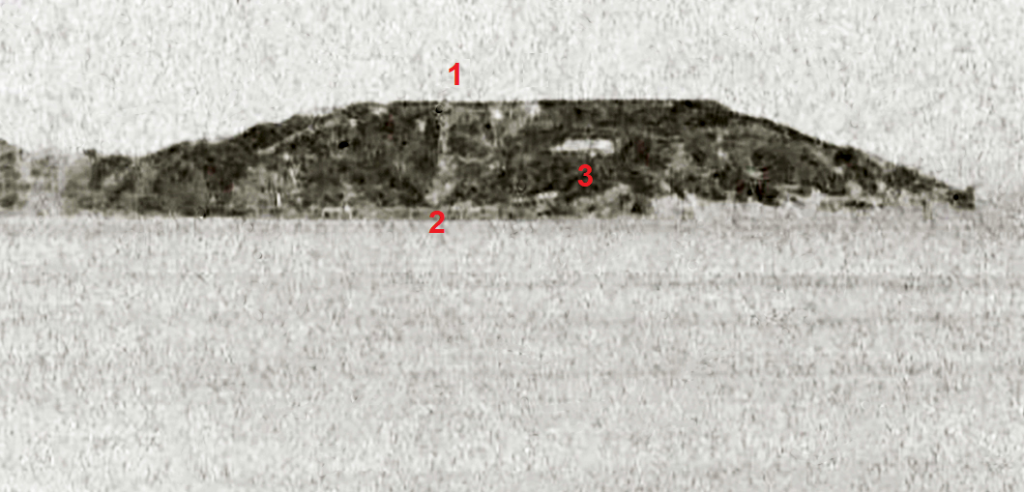
On the advice of Jervois and Scratchley, the Victorian Volunteer Artillery was disbanded on 31 December, 1880. The Parliament legislated for a replacement Corps of Permanent Artillery with an establishment of 128 men – to be supported in-time-of-war by paid part-time Garrison Artillery Militia, composed of a further 377 men. Until accommodation could be constructed at the Queenscliff battery Permanent Artillery recruits were to be temporarily stationed at Victoria Barracks in St. Kilda Road.
At the Heads in early 1881, the ‘… Chief Secretary inspected the defence works in course of completion ….. and expressed approval of the manner in which, the batteries were being constructed, and intimated his intention of carrying out the further recommendation of Sir William Jervois with regard to the armament at Swan Island and the fort meant to command the South Channel.’(ii) In April, Colonel Scratchley carried out an inspection at the Heads. While pleased with progress at Swan Island and Queenscliff, he noted the battery at Point Nepean was in poor repair and the sandbag walls were giving way. Scratchley, accompanied by Major Snee (Commanding the Queenscliff Artillery) and Mr. Bell (Inspector of Works) visited Point Nepean in February to decide on where to locate a third battery, so that its two guns would point seaward towards Bass Strait. They were also tasked with improving the two sandbag batteries ‘… giving way due to the harsh weather conditions.’(iii) In June 1882 Scratchley reported that no steps had been taken to improve the battery or commence permanent works at Point Nepean and that the four 80-pounders were dismounted and the wooden carriages quite unserviceable.
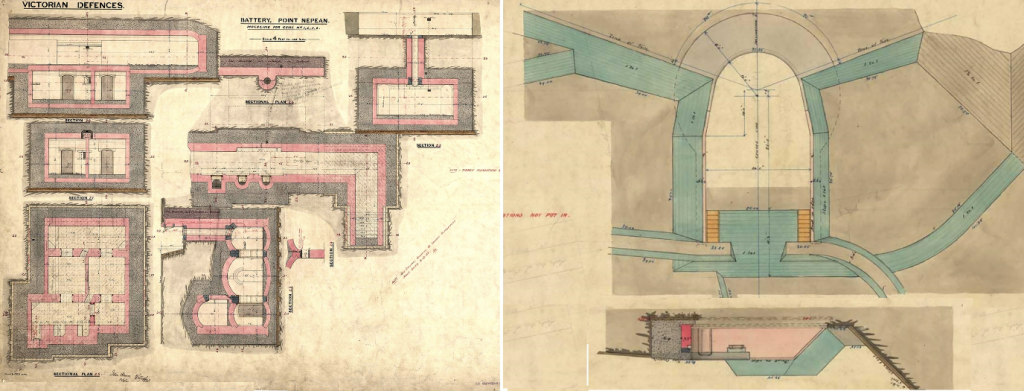
Left: NAA Drawing MP338/1 18, barcode 182444
Drawing No. 8 Underground magazines for 80-pdr guns 1, 2, 5, 6.
Right: (seaward) emplacement No.5 MP338/1 51 (section) barcode 1843192.
On March 9, 1882 a contract was gazetted for the construction of a jetty in the shallows on the narrow beach below the Point Nepean battery,(iv) although, it was not until July that the PWD began to test bore the ground for the construction of the permanent brick and concrete magazines and the concrete emplacement foundations. Ten preliminary bores were sunk through the drift sand to a depth of 30-ft., but failed to locate firm foundations.
The arrival on 2 February of three of the five vessels that made up the Russian Pacific Naval Squadron(v) carrying out a ‘goodwill cruise’ around the Pacific Ocean perimeter in 1882 had been hailed with considerable enthusiasm. The command cruiser, Afrika, had immediately entered the Alfred Graving Dock to be scraped, cleaned, and repainted below the waterline. There had been longboat races between Russian sailors and various naval crews during March. Following the squadron departure suspicion was aroused involving secret coded cables involving a mysterious Mr. Bryant, the Russian Admiral, and St. Petersburg. New torpedo designs, spying, and other intrigues became the focus of articles published by David Syme in ‘The Age’ newspaper.(vi) They implied an ‘intercepted confidential despatch’ had shown duplicity by Admiral Aslanbegoff and officers under his command,(vii) including the seeking out of weaknesses in the port defences of Auckland, Sydney, Melbourne, Hobart, and Adelaide – in anticipation of future hostilities.(viii)
The 2nd-class cruiser ‘Afrika’ (11½ -knots) was accompanied by two corvettes – ‘Vestnik’ and ‘Plastoun’. Afrika, although unprotected by armour, carried five deck-mounted Krupp 150mm L/26 steel guns and four Krupp 120mm guns.(xix) Krupp’s helical-prismatic ‘Slide’ breech mechanism gave the 6-inch gun a maximum range of four miles (7,000 yds.) and the 4.7-inch gun a range of three miles (5,200-yds), with a loading time of less than one minute.(x) In 1882, with the Victorian shore batteries stripped of guns, the need for harbour protection would likely have relied upon the monitor HMVS Cerberus and HMVS Nelson. The Russian guns, while superior to Victoria’s 80-pdr R.M.L. guns,(xi) were mounted on the open main deck, without shields. With a secondary armament of 120mm L/25 Krupp guns and Hotchkiss (French) 5-barrel revolving 37mm cannon,(xii) as merchant shipping raiders they were capable of holding their own against British cruisers; exactly how they would have fared in the restricted Port Phillip channels against the massive 400-lb projectiles of Cerberus’s 10-inch RML turret-guns remains an open question.
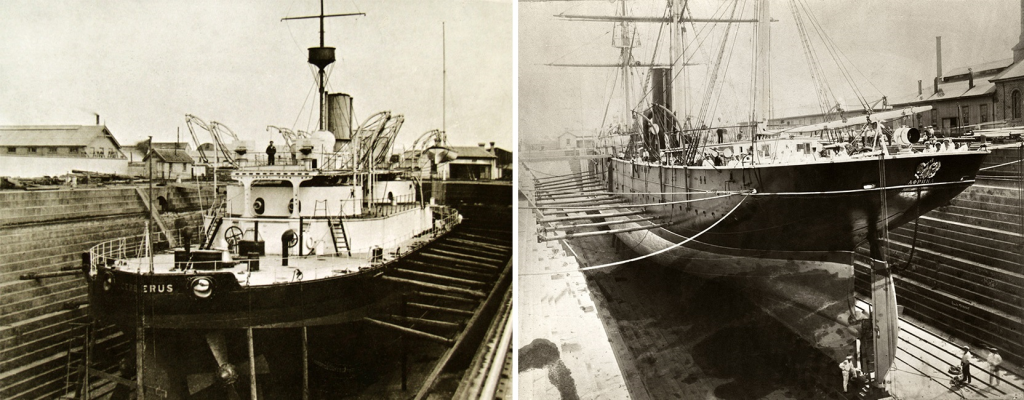
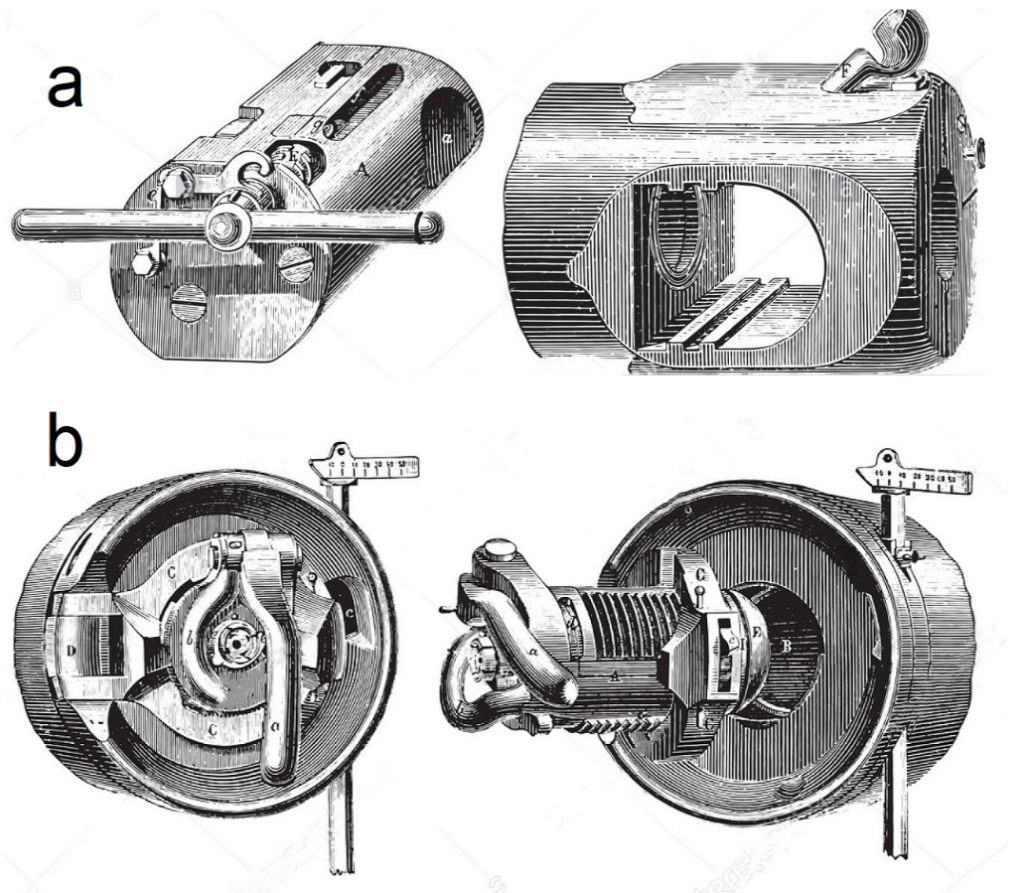
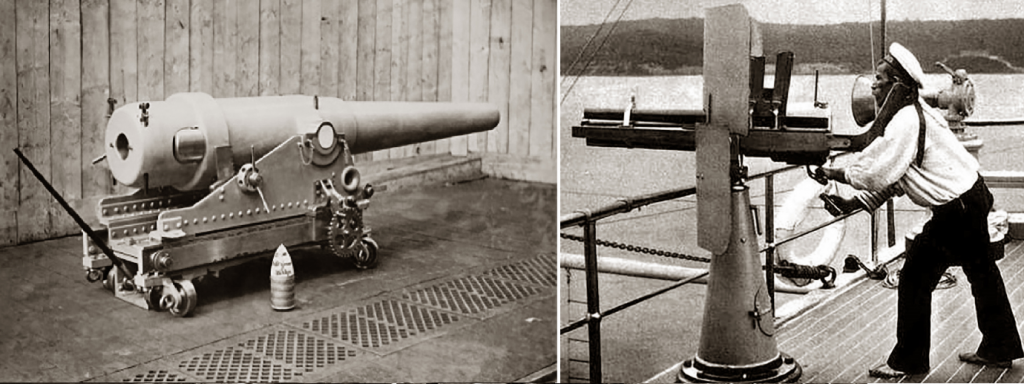
In April 1882 the P.W.D. surveyor, Mr. Seward, visited Point Nepean, ‘… laying out the lines, taking levels, and compiling measurements for the calling of tenders.’ It was intended to construct the Nepean works so that in the future Armstrong breech loading guns of large calibre and great penetrating power could be emplaced, if and when they became available. By June 1882 ‘The Argus’ was reporting ‘… the modified plan has not been carried out, and the temporary sand bag battery for four 80 pounders is now unserviceable.’(xiv) It reported that ‘… Mr. Finlay, (P.W.D.) went across to the Point Nepean battery to inspect the jetty in course of construction, where. … the jetty contractor – Mr. Mouat – had a great deal of difficulty to contend with, on account of the recent severe weather, and heavy seas rolling in at the Point, at times threatening to wash the whole of his timber away, but, fortunately, very little of it got adrift. He is now making good progress, and expects shortly to have the jetty completed.’(xv) By late July Mr. Stone (P.W.D) and a number of men, have been boring to test the ground for the new works ‘… to a depth of 30-ft and had not reached anything harder than drift sand.’ The jetty was nearing completion, but it appeared it should be ‘… extended another 30-ft. or 40-ft ‘…. so that vessel of moderate draught could remain alongside during the ebb tide.’(xvi)
Scratchley reported the plans for the permanent Nepean battery works were complete and on 25 August, 1882, John Horne was awarded the £14,286 17s 6d contract to construct six permanent gun emplacements and two magazines at Point Nepean.(xvii) The final contract drawings (by John Blackbourn – Scratchley’s assistant defence engineer) for three two-gun batteries were signed-off during September/October 1882.(xviii) An extension of the jetty into deeper water was carried out during October, before Horne and a few workmen arrived to prepare the construction site. Horne found it necessary to acquire steam-powered lifting gear to transfer the large amounts of cement, brick, and timber, building materials from the jetty up the scarp to the work site; 100-120 ft. above sea level.(xix) Defence fortification contracts were simultaneously underway at Queenscliff, Swan Island and Point Nepean during early 1883. Scratchley, who was returning to the U.K. after five years in the Australian colonies, was tasked with investigating Imperial attitudes to Victoria acquiring hydro-pneumatic ‘disappearing’ gun carriages for its 80-pdr M.L. guns at the Heads forts, and, to approach the colonial office over the possibility of obtaining the latest breech loading ordnance. The War Office was finding it impossible to supply the demand for 6-inch B.L. guns for the Royal Navy through its normal procurement channels.(xx) Scratchley directly approached the Elswick Ordnance Co. to supply H.P. carriages for the colony’s 80-pdr’s as well as 6-inch and 8-inch B.L. guns with H.P. or Vavasseur carriages.
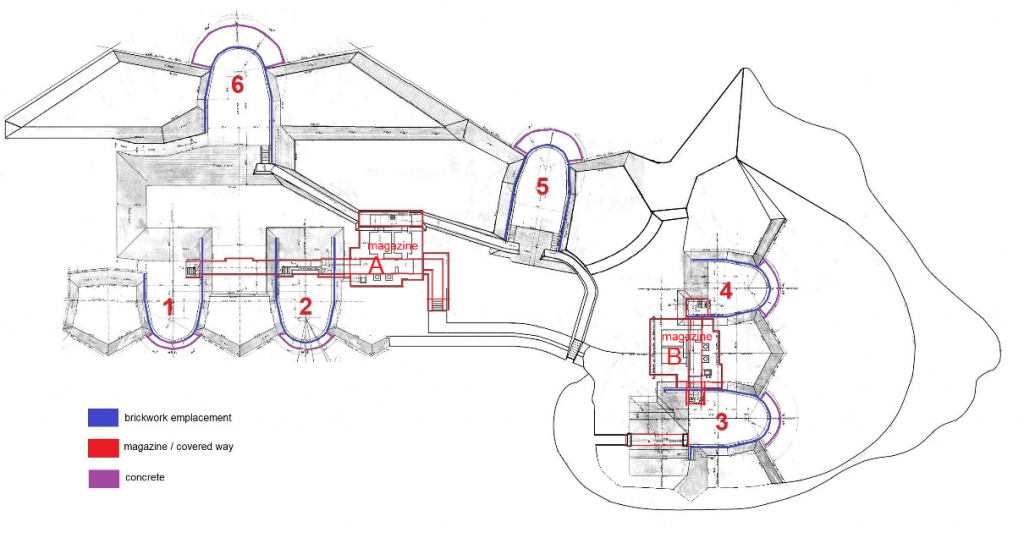
Composite of four NAA Drawings No.’s MP338/1 48, barcode 1843167; MP338/1 49, barcode 1843173; MP338/1 50, barcode 1843182; MP338/1 51, barcode 1843192 – showing the completed Point Nepean battery works for six 80-pdr RML guns c.1885
In the interim the Victorian parliament, on the advice of Admiral Tryon (Commander of the R.N. Australia squadron), decided to increase the naval force by supplementing the breastwork-monitor HMVS Cerberus with two Alpha/Beta-class gunboats – to be purchased from Sir William Armstrong in the U.K. One gunboat was to carry a bow mounted 10-inch R.B.L. gun and the other a similarly mounted 8-inch R.B.L. gun.(xxi) The obsolete wooden-frigate HMVS Nelson was to be fitted with several rapid fire guns and Nordenfeldt machine guns on the upper deck so as to act as an ‘armed stores ship’ in the squadron’s defence of the Heads channels. Along with other Australian Victoria was advised to purchase Thornycroft ‘fast’ torpedo boats, fitted-out to carry spar and Whitehead torpedoes.(xxii)
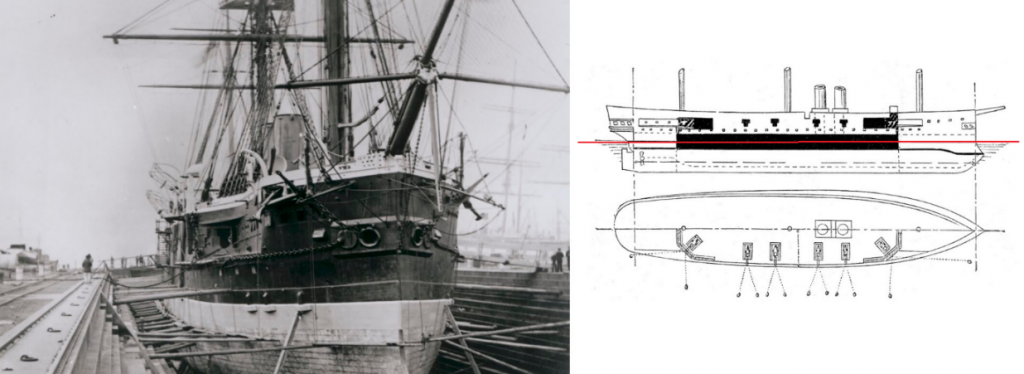
Arrival of the R.N. protected ironclad HMS Nelson at Sydney on 8 January 1882 to command the RN Australia Squadron had greatly improved the naval defence situation. It was initially thought the vessels displacement of 7,473 tons and draught of 23’ 9” would prohibit ingress through the Port Phillip channels, but she successfully entered Port Phillip to utilize the Alfred Graving dock on 30 November 1882, after the dredge Alligator had completed excavation of a shoal at the entrance to South Channel.(xxiii)
In August 1883 ‘The Argus’ reported £4,000 of the £11,400 Horne contract had already been spent, and that an additional sum of about £15,500 would be required.(xxiv) A month later ‘The Weekly Times’ in evaluating the state of Victoria’s defences commented on the ’formidable’ colonial naval squadron and postulated the ‘… fleet when stationed behind effectively constructed and armed forts at Queenscliff, Point Nepean, Swan Island, and in the South Channel, constituted a defence against attack by sea that may be considered impregnable, when our distance from the base of operations of any of the great naval powers is remembered. In addition to Port Phillip, the ports of Belfast, Portland, and Warrnambool were to be defended by batteries, which will be manned by local garrison artillery militia.’(xxv)
In late 1883, clearly anticipating adoption of the interrupted screw breech gun and hydro-pneumatic carriage to coastal fortifications, Scratchley ‘… had been engaged with General Steward in considering the designs for the works required to complete Swan Island, Queenscliff, and Point Nepean batteries. Having carefully weighed the question of guns and the best mode of mounting them, having special regard for increasing the protection afforded to the gunners we decided to adopt the following armaments; Point Nepean – One 6-in. gun, to be mounted in one of the emplacements facing seawards, one 8-in. 11½ ton gun to be mounted as a salient gun on the point. Both these guns to be on hydro-pneumatic carriages with overhead steel shields …. Besides the foregoing, we also decided that the 80-pounder guns of 80-cwt. now in the batteries at Point Nepean (five), Queenscliff (four), and Swan Island (three) in all 12, should be mounted on hydro-pneumatic carriages without steel overhead shields.’(xxvi)
Horne’s 1882 contract necessitated dismantling the sandbag works at Nepean to excavate new foundations for emplacements, connecting passages, covered-ways, and two brick and concrete magazines, plus additional battery revetments. The contract included two gun new emplacements (5 & 6), constructed on the unprotected southern face of the fortification to prevent vessels in Bass Strait attacking from seaward. Construction left the defences at Nepean without mounted ordnance for over 2½ years.
On accompanying an official visit to Point Nepean in January 1885, a correspondent from ‘The Argus’ newspaper observed; ‘The builders of the batteries had a hard task trying to get a sound foundation with the sand coming into the works like water in a mine, but they succeeded at last, and the visitor is lost in perfect catacombs of magazines- powder rooms, shell rooms, and stores for other munitions of war- emplacements, and underground galleries. There is room for 200-tons of ammunition, and it is to be kept in bomb-proof cells, far from the reach of an enemy’s fire. There are lifts for the huge powder cartridges and shot and shell which the big guns on the summit of the hill will carry. Moreover, Point Nepean is not an inviting place to carry by storm; its steep sides are covered with scrub affording excellent cover for infantry while they repel landing parties. A troop of sharp shooters such as the Rifle Association could send down, supported by the murderous Gatling or Nordenfeldt should be a chilling reception for invaders exposed in open boats to invisible assailants on the heights above. The present state of the work was reached about 18 months ago. No one lives on the point, but it is probable that some of the garrison artillery will be sent there as soon as the barrack accommodation has been improved. The guns are not yet mounted, nor all the emplacements built; the armament will comprise four 80-pounders, three 8-inch guns, and some Nordenfeldt’s or Gatling’s. The hoisting of the guns from the beach up so steep an ascent over such soft ground, is a herculean task worthy of the ability of Captain Ind and the muscles of his stalwart garrison artillery.’(xxvii)

A defence memorandum written by Scratchley on 15 February 1884(xxx) included a statement that a (War Office) tracing was being forwarded on ‘…. the works required to complete Nepean battery according to the latest ideas, and introducing all modern appliances.’
(a) It is intended to add three 8-in guns (new type) to the armament – one at the salient in front of the battery and at a lower level the other two in place of two of the 80 pounders – one to fire to seaward, and the other to fire on the inner anchorage and the approach to the South Channel. The main reason for this addition to the armament is that, with an armament of 80-pounders only, the artillery could be easily overpowered and after the guns had been more or less silenced the enemy could, by keeping close in shore and away from Queenscliff, pass rapidly up the approach to the South Channel. Had the original scheme for the South Channel fort been carried out at a cost of some £350,000 the necessity of a powerful battery on Point Nepean would not have been so great. Now however the case is different and we must revert to Sir William Jervois’s original proposal to place heavy guns on the point, and make the defence of the South Channel approaches as effective as that of the West Channel.
(b) It is also imperatively necessary to mount the remaining four 80-pounders on disappearing carriages, to increase the protection afforded to the gunners and screen the guns from the enemy’s view. One carriage has been ordered three more are required.
(c) The arrangement, proposed for rendering the battery self-defensible are shown on the plan and will have to be carefully considered on the spot.
(d) The barracks are shown with flat roofs. This is a detail of little importance, if the contract for the buildings has not been let this mode of construction might be adopted as rendering it easier to screen the barracks from view to seaward.
(e) Machine guns will have to be provided for the battery. The number must be considered on the spot after the defensible accessories have been settled.
The Agent-General did not sign the Armstrong Elswick Works contract for twelve H.P. carriages for 80-pdr guns until July 1885 – at a cost of £16,200.(xxxi) Such a delay was understandable, as trials to resolve mechanisms for the H.P. carriages were still underway in the U.K. and an investigation by Sir Andrew Clarke R.E. (Inspector-General of Fortifications 1882-1886) of the naval attack on Alexandria harbour (Egypt) in 1882 – by eight of the largest and most heavily armed ironclads and six gunboats – opined that it was a less than convincing triumph, during which an enormous number of projectiles had been expended (the vast majority overshooting the target) while damage to the earthwork batteries had been light and repaired overnight.(xxxii)
Victoria’s move to acquire and install large breech loading ordnance and hydro-pneumatic carriages required an extensive War Office re-examination of the existing Heads fortification plans. However, the Anglo-Russian ‘Panjdeh’ war scare in March-April led the Australian colonies to prepare for a possible Russian naval attack on their harbours and port facilities. There was an immediate rush to prepare ‘en barbette’ R.M.L. gun emplacements at Queenscliff, Swan Island, South Channel, Point Nepean and Point Franklin.
Two of the four 80-pdr guns already at Nepean were repositioned on April 20, the others on April 22. ‘The Age’ of May 4, 1885, reported that during the previous week, two 9-inch guns on Swan Island had been temporarily repositioned to South Channel annulus, with a third 9-inch gun landed on the beach at Point Nepean. The permanent Submarine Mine Corps was still being formed and its R.E. officer, Capt. Ellery, had been refused permission to depart the U.K. The small Victorian Volunteer Torpedo Corps was in the process of relocating mines, cables, and electrical stores, from Williamstown to Swan Island, so the gunboat Victoria proceeded to South Channel with coils of hawser rope, ‘…. to be used in trying the experiment of rendering the entrance to the channel practically unnavigable for an enemy’s vessel by means of floating lines attached to grappling irons and heavy hooks, be placed as to catch into the propeller of any screw steamer attempting to pass them, and thus paralyse its action.’(xxxiii)
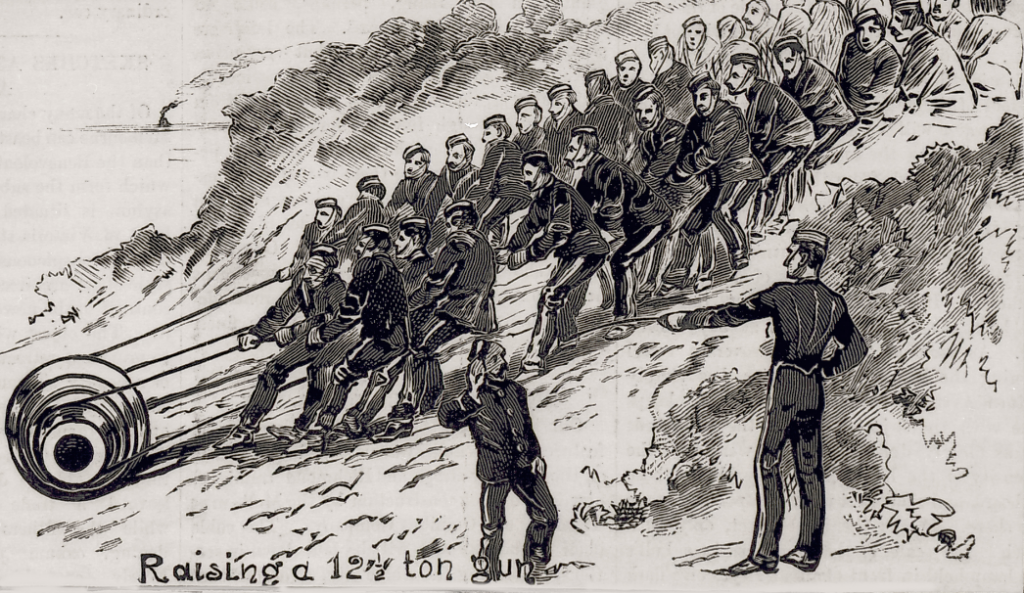
On May 6, 1885, Captain Ind R.A. (Garrison Commander, Fort Queenscliff) and 40 Permanent Artillerymen were busy readying the 9-inch gun to be parbuckled from the beach up to an emplacement on the point. This new position provided a clear range across the Rip entrance into Bass Strait, then through a 180⁰ arc towards the quarantine grounds. A racer bed had been prepared and nearby excavations for the 9-inch magazine constructed from redgum timber were complete. Within days the new gun had been placed in position, but, the breast work that consisted of 10 feet of concrete had not been commenced. Emplacements for two more 80-pounder guns have been prepared in the top fort and a connecting extension of the rifle pits was also being dug out.(xxxiv) At Queenscliff a quantity of 9-inch projectiles had been landed ready to be forwarded across the bay as soon as the magazine was complete and the garrison was preparing cartridges. Members of the Torpedo Corps commanded by Captain Joseph had prepared three electrical lights with their boilers and machinery at Swan Island. Two were taken by barge to Queenscliff, the third was destined for Point Nepean – after the electrical engine shed and other works were complete.(xxxv)
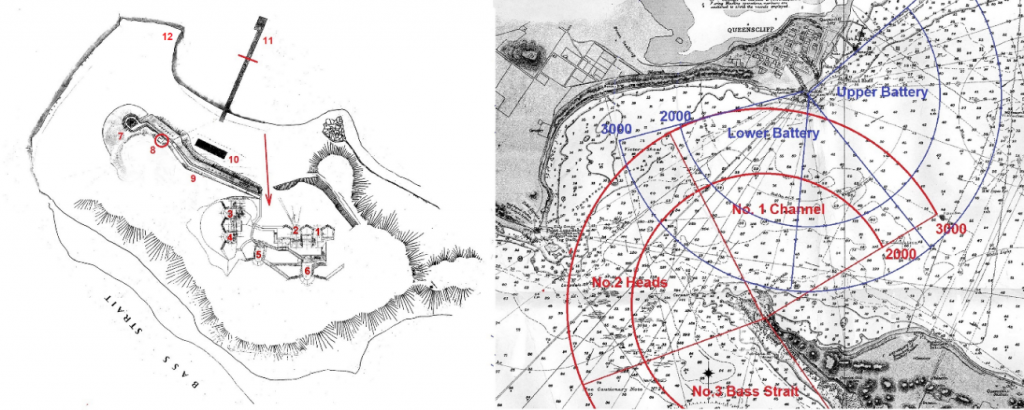
Above Right: Gun zones 1, 2, 3, showing 2000-3000 yards range – Nepean and Queenscliff Batteries – 1885
‘The Australasian’ reported further progress, with the 9-inch gun from Swan Island had been placed in position at Point Nepean. On 7 May, the gun was ‘ready for fighting’ and the contractors were ‘… laying the foundations of the 10-ft concrete wall to protect the gunners on the seaward side. In the course of a day or two, the work of constructing a stockade to protect the battery in the rear was to be commenced, a work … absolutely necessary in order to shelter the gunners from the effects of shell explosions.’(xxxvi)
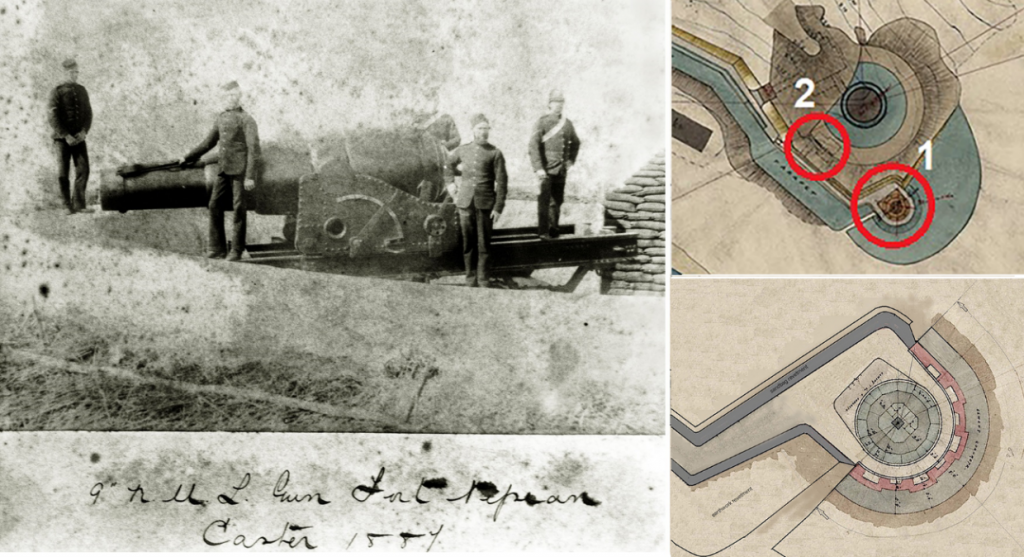
Photo collection – Fort Queenscliff A.A.H.U. Above Right: Emplacement No.7 – 1. 9-in R.M.L. Gun emplacement; 2. 9-inch (redgum) Magazine. Reference: AA MP338/1 36.
(i) Detail section from Military Camp, Queenscliff 1882 / Frederick Kruger. NGV accession No. 1997.204
(ii) Argus Tuesday 8 February 1881 State of the Heads Defences. Page 4
(iii) Argus. Saturday 30 April 1881. The Defence at the Heads. Page 8
(iv) Gazette 25. Friday, March 10 1882. Contract 2391. Jetty for defence purposes, Point nepean £573 10s 9d; John Mouat
(v) Afrika, Vestnick, Plaston. (Walenski, Petrolin.)
(vi) Horsham Times. 28 March 1882. Russian Designs on Melbourne. Page 3
(vii) Admiral Avraamy Bogdanovich Aslanbegoff (Aslanbegov) (1822-1900) Commander of the Russian Pacific Squadron in 1881-1882
(viii) Lack. Clem Llewellyn (1900-1972) Russian Ambitions in the Pacific: Australian War Scares of the 19th Century. Journal of the Royal Historical Society of Queensland. Vol 8. Issue 3. pp 432-459
(ix) Afrika, H.I.M.S. 2,500 tons, Armament- 5 Krupp 6-inch BL guns, 5 Krupp 4-inch BL guns 5 2-pdr guns. Captain Alexeieff; Vestnik, H.I.M.S. 1,310 tons, 3 Krupp 6-inch BL guns, 4 Krupp 4-inch BL guns. Captain Avelan; Plastoun, H.I.M.S. 1,310 tons, 3 Krupp 6-inch BL guns, 4 Krupp 4-inch BL guns, Captain Poliansky.
(x) Evening Journal (Adelaide) Monday 27 February 1882. Arrival of the Russian Squadron – Adelaide. Page 3
(xi) United States Consular Report on the Commerce, Manufacturers, etc., of their Consular Districts – 1882-3 Krupp’s Steel Ordnance Works at Essen by Consul Potter of Crefeld – Krupp and Armstrong guns. Pages 570-579. Google EBook- Free
(xii) The 1-pdr Hotchkiss revolving 37mm cannon was capable of firing 68 rounds per minute – with an accuracy range of 2,000 yards (1,800 m).
(xiii) Kaufmann J.E., Kaufmann H.W. The Forts and Fortifications of Europe 1815-1945: The Central States- Germany, Austria-Hungary & Czechoslovakia by – Page 18
In 1886 the Grüson Co., Magdeburg, tested 15cm Krupp guns against iron turrets at a range of 1000 yards and scored 36 hits, causing only minor damage. They then fire 33 rounds at 55m (with reduced charges) and failed to make the turrets unserviceable. All damage was repaired by the following day.
(xiv) Argus. Wednesday 7 June 1882. The Defences of Victoria. Page 10
(xv) Weekly Times. Saturday 3 June 1882. Official Inspection of the heads Batteries. Page 13
(xvi) Weekly Times (Melbourne). Saturday 22 July 1882. The Defences at the Heads. Page 10
(xvii) Geelong Advertiser. Friday 25 August 1882. PWD Tenders accepted. Page 3
(xviii) National Archives of Australia Drawings; Victorian Defences Nepean Battery 1882
MP338/1 18 barcode 842444; MP338/1 48 barcode 843167; MP338/1 49 barcode 843173; MP338/1 50 barcode 843182; MP338/1 51 barcode 843192
(xix) Argus Saturday 2 September 1882. The Defence Works Page 12
(xx) Geelong Advertiser 28 June 1883 Navy Breech Loaders. Page 3
(xxi) Argus 7 March 1882. Improved Naval Defence – Report of Captain Mandeville. Page 10. HMVS Victoria & HMVS Albert – gunboats. Torpedo boats – TB Childers & TB’s Nepean & Lonsdale
(xxii) Ibid.
(xxiii) Argus. 9 January 1882. Government reports. Page 6
(xxiv) Geelong Advertiser. 13 January 1882. The dredge Alligator. Page 2
(xxv) Weekly Times. 29 September 1883. Defence, Not Defiance. Page 8
(xxvi) Argus. 1 January 1884. Major-General Scratchley in England. Page 3
(xxvii) Argus. 10 January 1885. Victorian Defences. Inspection of the Fortifications. Page 10
(xxviii) Glacis: An earth slope angled away from the ditch; the height and angle of the glacis was calculated to protect the rampart from direct fire but to allow the defenders to fire over it.
(xxix) Australian Sketcher. 4. 5. 1885. Our Defences. 9-inch gun, Queenscliff Battery (section).SLV Accession no: A/S04/05/85/73
Australian Sketcher. 1. 9. 1885. Coast views – Melbourne to Sydney & Newcastle (section).SLV Accession no: A/S21/09/85/157
(xxx) Argus. 4 April 1884. The Victorian Defences. Page 10
(xxxi) Age. 23 July 1885. Parliament. Defence minister’s Report. Page 6
(xxxii) https://www.mhhv.org.au/south-channel-fort-part-2-1883-1893-by-keith-quinton/
(xxxiii) Geelong Advertiser. 4 May 1885. Defence preparations. Page 3.
(xxxiv) Argus. 7 May 1885. The Defence Works at the Heads. Page 6
(xxxv) Ibid.
(xxxvi) Australasian. 9 May 1885. The Defence Force. Page 30
Contact Keith Quinton about this article.






